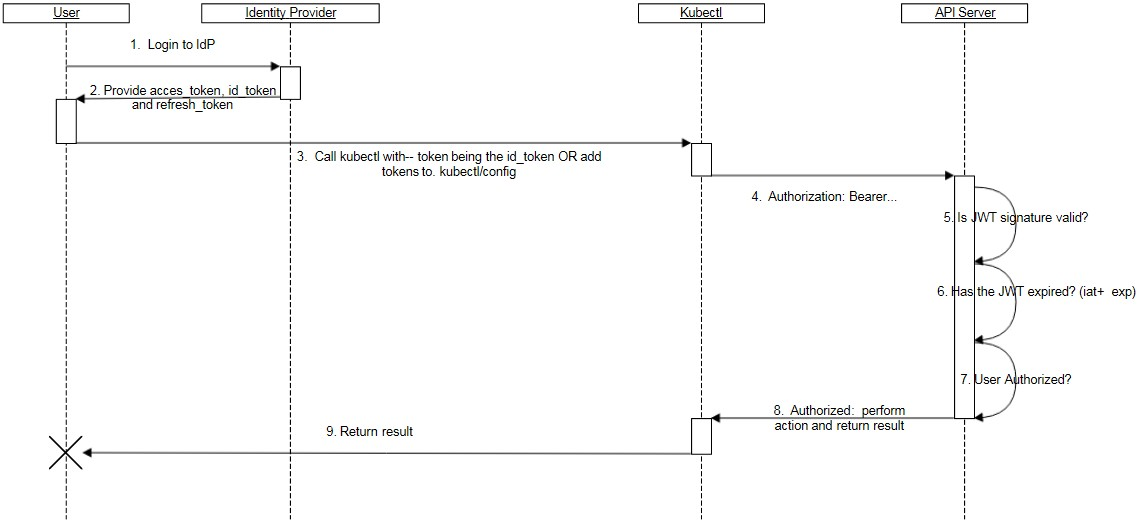您好,登錄后才能下訂單哦!
您好,登錄后才能下訂單哦!
如何進行k8s的認證和授權,很多新手對此不是很清楚,為了幫助大家解決這個難題,下面小編將為大家詳細講解,有這方面需求的人可以來學習下,希望你能有所收獲。
一、概述
Kubernetes只負責管理Service賬戶,不管理普通用戶的賬戶。Kubernetes沒有代表普通用戶帳戶的對象。 普通用戶信息無法通過API添加到集群。普通用戶由外部獨立服務管理。K8s通過authentication插件來實現用戶認證。K8s本身不管理用戶,也不會提供token。
二、k8s支持的認證類型
K8s支持X509 Client證書、token、basic auth認證等。
X509 Client證書:
啟動API Server時通過--client-ca-file=SOMEFILE選項提供給API Server。
靜態token文件:
1)啟動API Server時通過--token-auth-file=SOMEFILE選項提供給API Server。
token文件是csv文件,包含如下內容:
token,user,uid,"group1,group2,group3"
2)通過在http header中提供token信息以完成認證
Authorization: Bearer 31ada4fd-adec-460c-809a-9e56ceb75269
31ada4fd-adec-460c-809a-9e56ceb75269為具體的token值。
Bootstrap Token
相比于靜態token而言,此類token可動態管理。
basic auth:
1)需要將包含password、username、uid、group等信息的csv文件通過--basic-auth-file=SOMEFILE選項提供給API Server,在API Server啟動時加載。
2) 需要在http的header中填寫Authorization頭,其中包含“USER:PASSWORD”的Base64編碼后的字符串。
OpenID Connect Token:
采用OAuth3令牌響應的id_token(而不是access_token)作為承載令牌。
需要首先向身份提供商進行身份驗證。然后采用身份提供商給你的id_token訪問K8s。在Header中添加:Authorization: Bearer XXXXXXX
要使用該認證方式,需要配置API Server:
--oidc-issuer-url 身份提供商的URL,如:https://accounts.google.com,必選
--oidc-client-id 客戶端標識,如:kubernetes ,必選
其他可選參數參見:https://kubernetes.io/docs/reference/access-authn-authz/authentication/#openid-connect-tokens
身份提供商需要支持OpenID Connect規范。
webhook Token認證:
集群中需要配置如下兩個參數:
--authentication-token-webhook-config-file 用于配置remote service(負責認證)的文件
--authentication-token-webhook-cache-ttl 用于配置身份認證結果的緩存時間,默認2分鐘
webhook采用kubeconfig文件格式進行配置,文件中clusters是指remote service,而users是指API服務器webhook,如下示例:
# Kubernetes API version # users refers to the API server's webhook configuration. # kubeconfig files require a context. Provide one for the API server. |
當客戶端需要認證攜帶的token時,authentication webhook向remote service POSTs一個 JSON格式的authentication.k8s.io/v1beta1 TokenReview對象,如下示例:
| { "apiVersion": "authentication.k8s.io/v1beta1", "kind": "TokenReview", "spec": { "token": "(BEARERTOKEN)" } } |
remote service需要解析上述json,并對token進行校驗,然后通過response填寫校驗結果,成功的response如下示例,且http code必須是2XX:
| { "apiVersion": "authentication.k8s.io/v1beta1", "kind": "TokenReview", "status": { "authenticated": true, "user": { "username": "janedoe@example.com", "uid": "42", "groups": [ "developers", "qa" ], "extra": { "extrafield1": [ "extravalue1", "extravalue2" ] } } } } |
失敗的response如下示例:
{ "apiVersion": "authentication.k8s.io/v1beta1", |
Authenticating Proxy:
API服務器可以根據header values配置來識別users ,如X-Remote-User。
在API Service啟動時進行相關配置,指明http的header中哪些key代表用戶名、哪些代表用戶的group等,如下示例:
--requestheader-username-headers=X-Remote-User
--requestheader-group-headers=X-Remote-Group
--requestheader-extra-headers-prefix=X-Remote-Extra-
如果發送請求如下:
GET / HTTP/1.1
X-Remote-User: fido
X-Remote-Group: dogs
X-Remote-Group: dachshunds
X-Remote-Extra-Acme.com%2Fproject: some-project
X-Remote-Extra-Scopes: openid
X-Remote-Extra-Scopes: profile
將產生如下用戶信息:
name: fido
groups:
- dogs
- dachshunds
extra:
acme.com/project:
- some-project
scopes:
- openid
- profile
為了防止header欺騙,Authenticating Proxy需要在檢查請求header之前,向API服務器提交有效的客戶端證書,以針對指定的CA進行驗證。
–requestheader-client-ca-file 必選, PEM-encoded的證書包。在為用戶名檢查請求header之前,必須根據指定文件中的證書頒發機構呈現和驗證有效的客戶端證書。
–requestheader-allowed-names 可選,(common names)通用名稱(cn)List。如果設置,則在檢查請求header用戶名之前,必須提交List中指定(common names)通用名中有效的客戶端證書。
CA證書生成腳本:
#!/bin/bash mkdir -p ssl cat << EOF > ssl/req.cnf |
openssl genrsa -out ssl/ca-key.pem 2048
openssl req -x509 -new -nodes -key ssl/ca-key.pem -days 10 -out ssl/ca.pem -subj "/CN=kube-ca"
openssl genrsa -out ssl/key.pem 2048
openssl req -new -key ssl/key.pem -out ssl/csr.pem -subj "/CN=kube-ca" -config ssl/req.cnf
openssl x509 -req -in ssl/csr.pem -CA ssl/ca.pem -CAkey ssl/ca-key.pem -CAcreateserial -out ssl/cert.pem -days 10 -extensions v3_req -extfile ssl/req.cnf
三、K8s雙向認證
k8s雙向認證時,客戶端證書的O={group},CN={username}
webhook方式下,k8s收到客戶端證書解析group和username,與webhook插件進行交互對用戶及權限進行認證
客戶端kubeconfig只需要在users下配置客戶端證書和私鑰文件:
client-certificate
client-key
embed-certs=true
注:接入CISM時填寫group和username、選擇CA根證書文件,VNFM服務端自動生成客戶端證書和秘鑰文件,動態修改kubeconfig配置文件
或直接選擇客戶端證書,這種場景下需要事先確定VNFM使用的用戶名和對應的group,先制作客戶端證書,建議采用這種方式。界面上不需要用戶填寫group和username
webhook token認證:
從webhook的組件獲取token
在header中帶給k8s
k8s和webhook通訊對token進行認證
webhook返回認證結果(用戶名、組、額外信息)
服務端開啟--authentication-token-webhook-config-file和--authentication-token-webhook-cache-ttl
# Kubernetes API version
apiVersion: v1
# kind of the API object
kind: Config
# clusters refers to the remote service.
clusters:
- name: name-of-remote-authn-service
cluster:
certificate-authority: /path/to/ca.pem # CA for verifying the remote service.
server: https://authn.example.com/authenticate # URL of remote service to query. Must use 'https'.
# users refers to the API server's webhook configuration.
users:
- name: name-of-api-server
user:
client-certificate: /path/to/cert.pem # cert for the webhook plugin to use
client-key: /path/to/key.pem # key matching the cert
# kubeconfig files require a context. Provide one for the API server.
current-context: webhook
contexts:
- context:
cluster: name-of-remote-authn-service
user: name-of-api-sever
name: webhook
webhook授權:
服務端開啟--authorization-webhook-config-file
# Kubernetes API version
apiVersion: v1
# kind of the API object
kind: Config
# clusters refers to the remote service.
clusters:
- name: name-of-remote-authz-service
cluster:
# CA for verifying the remote service.
certificate-authority: /path/to/ca.pem
# URL of remote service to query. Must use 'https'. May not include parameters.
server: https://authz.example.com/authorize
# users refers to the API Server's webhook configuration.
users:
- name: name-of-api-server
user:
client-certificate: /path/to/cert.pem # cert for the webhook plugin to use
client-key: /path/to/key.pem # key matching the cert
# kubeconfig files require a context. Provide one for the API Server.
current-context: webhook
contexts:
- context:
cluster: name-of-remote-authz-service
user: name-of-api-server
name: webhook
雙向認證和token可以并存,如下:
user 定義用于向 kubernetes 集群進行身份驗證的客戶端憑據。
可用憑證有 client-certificate、client-key、token 和 username/password以及embed-certs。
username/password 和 token 是二者只能選擇一個,但 client-certificate 和 client-key 可以分別與它們組合。
可以使用 kubectl config set-credentials 添加或者修改 user 條目。
--embed-certs=true:將 ca.pem 和 admin.pem 證書內容嵌入到生成的 kubectl.kubeconfig 文件中(不加時,寫入的是證書文件路徑);
helm方式訪問k8s時,如果要支持token,需要在kubeconfig中設置token,如果token動態獲取,則需要定時修改kubeconfig文件。
kubeconfig例子:
apiVersion: v1
clusters:
- cluster:
certificate-authority: fake-ca-file
server: https://1.2.3.4
name: development
- cluster:
insecure-skip-tls-verify: true
server: https://5.6.7.8
name: scratch
contexts:
- context:
cluster: development
namespace: frontend
user: developer
name: dev-frontend
- context:
cluster: development
namespace: storage
user: developer
name: dev-storage
- context:
cluster: scratch
namespace: default
user: experimenter
name: exp-scratch
current-context: ""
kind: Config
preferences: {}
users:
- name: developer
user:
client-certificate: fake-cert-file
client-key: fake-key-file
- name: experimenter
user:
password: some-password
username: exp
其中certificate-authority、client-certificate、client-key是證書和秘鑰文件的路徑,如果使用BASE64加密后的數據,則需要采用下面的代替:
certificate-authority-data, client-certificate-data, client-key-data
看完上述內容是否對您有幫助呢?如果還想對相關知識有進一步的了解或閱讀更多相關文章,請關注億速云行業資訊頻道,感謝您對億速云的支持。
免責聲明:本站發布的內容(圖片、視頻和文字)以原創、轉載和分享為主,文章觀點不代表本網站立場,如果涉及侵權請聯系站長郵箱:is@yisu.com進行舉報,并提供相關證據,一經查實,將立刻刪除涉嫌侵權內容。